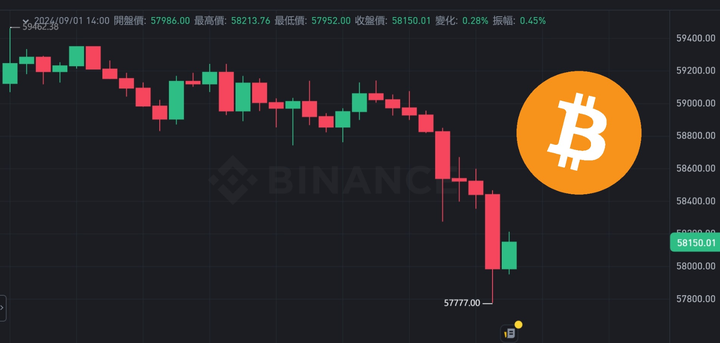Although the U.S. personal consumption expenditures index (PCE) for July, released on August 30, slowed down, which further strengthened the market's confidence in the Federal Reserve's September rate cut, the cryptocurrency market has not improved in recent days. Bitcoin has fallen from around $59,000 since 6 a.m. this morning, and fell as low as $57,777 at 1 p.m., a drop of more than 2%.
Ethereum also plummeted today, with its price falling from around $2,520 at 6 a.m. this morning to as low as $2,458 at 1 p.m., breaking below the $2,500 mark. It rebounded slightly before press time and is now trading at $2,472, down 2% in the past 24 hours.
More information Tuanzi Finance
If Bitcoin falls below $56,000, it will trigger a huge liquidation
It is worth noting that if Bitcoin falls below $56,000, the cumulative long order liquidation intensity of mainstream centralized exchanges such as Binance, OKX, and Bybit will reach $465 million. If Bitcoin rebounds and breaks through $60,000, the cumulative short order liquidation intensity of mainstream centralized exchanges will reach $860 million, so the next trend will be worth paying attention to.
The Liquidation Map provides a visual chart of trader liquidations in the futures crypto market. The map predicts upcoming liquidations based on previous price movements. When a small number of position clusters are liquidated, the impact on the market is small, but if the liquidation prices of thousands of position clusters are close to each other, and these orders are liquidated at the same time, the impact on market prices will be huge.
A decline caused by recession fears?
The pundits are out in force these days, but it's hard to see any signs of an impending recession.
What we are seeing are signs of fiscal spending, currency debasement, and increased global liquidity – signs that should be bullish for risk assets like cryptocurrencies as we move into the second half of this year and as we head into 2025.
On-chain data
Long-term holders
Long-term Bitcoin holders saw some profits at the end of Q1 and Q2. So far, the market has been volatile for about five months (including two 20%+ declines and one 30%+ decline).
Over the past few weeks, we have been seeing initial signs that long-term holders have returned to the market as buyers.
Bitcoin Miner
For the first time in nearly a year, Bitcoin miners’ BTC accumulation exceeded their BTC sales. Coupled with the German government’s sale of $2.5 billion in BTC in July, miners’ shift from net sellers to buyers may stabilize the market and lay the foundation for the next upward wave.
Stablecoins
Total stablecoin balances are now just back to their highs from late 2021. I think this is part of the reason why Bitcoin is having trouble breaking out of its all-time highs.
There is not enough liquidity in the system.
The impending rate cuts and rising liquidity suggest there is a potential migration of investors away from money market accounts, which currently hold nearly $6.5 trillion.
Continuous selling
It should also be mentioned that there have been a lot of recent sales of large amounts of BTC and ETH by a number of larger entities:
The German government sold $2.5 billion worth of BTC in June and July of this year.
Jump Crypto sold nearly $400 million in ETH in July and August of this year.
To date, MtGox creditors have received about $3 billion, with another $5.8 billion to be distributed (we assume a lot of this was sold, leaving creditors potentially sitting on huge proceeds).
The court approved the distribution of $12.7 billion of FTX to customers on August 9, and all claims of $50,000 or less (98% of claimants) will be paid by October 9.
Of course, in the long run, this is all noise, but I think it is a factor in the consolidation and volatility we have seen this summer. As the selling subsides, a solid foundation may be formed leading to the next bull run.
End of the article
In many ways, the movement we saw in Bitcoin from Q4 last year to Q1 this year ($27,000 to $73,000) is similar to what we saw in 2019 ($4,000 to $14,000). In 2019, crypto native users were very excited and thought we would return to all-time highs. But the reality was that there were no new users entering the crypto space at that time. Ultimately, Bitcoin experienced a full year of consolidation (and recovery from the panic of the new crown epidemic) and finally broke through the all-time high in Q2 2021, reaching $66,000, coinciding with interest rate cuts, currency debasement, and the election cycle.
After BTC firmly broke through its all-time high, we saw an explosion in the number of new users, the emergence of countless DAOs, the rise of DeFi, a 10-fold increase in stablecoin issuance, the explosion of NFTs, and crypto-native users with high confidence and optimism in the cryptocurrency market, showing a "WAGMI" sentiment.
If history repeats itself, the frenzy could emerge later this year and last until 2025.











